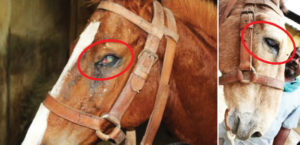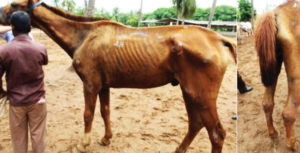Equines are being injected toxins to produce anti-venom serum, a practice that involves abuse of the animals and may in fact be ineffective
Horses, mules and donkeys are not just used for weddings, rides, and lugging heavy loads but also as blood banks, thanks to their ability to produce anti-toxins.
Housed in cramped spaces, some are tied, have to stand in their own urine and faeces. Others are unable to even bear their own weight due to sickness, and have gaping wounds. This is the condition of equines who are kept alive to pump out serums for human use.
These were the findings of an Animal Welfare Board of India authorised inspection in 10 biopharmaceuticals. A dismaying picture emerged, with evidence of widespread abuse, including deprivation of much-needed veterinary treatment. This inspection took place in 2015, but till date nothing has happened to ameliorate the plight of these animals.
Violations of all types are rampant. Many facilities did not even have a licence. Animals younger than three years and older than 25 were found being used for bleeding programmes, which is not permissible under guidelines issues by the Committee for the Purpose of Control and Supervision of Experiments on Animals (CPCSEA).
And yet, the flouting of rules continues unabated. In March 2017, while one company —Mediclone Biotech Pvt Ltd based in Chennai, Tamil Nadu — had their experimentation license suspended by CPCSEA, an inspection by PETA India reportedly found the practice alive and thriving in 2018.
To understand the problem at hand, one must also look into what purpose the blood of these mammals serves. The equines produce anti-toxins which are used for purposes such as anti-venom serums and also a disease well known to India — diphtheria. The anti-toxin is produced by repeatedly exposing them to doses of a toxin, often in conjunction with an adjuvant to stimulate the immune response.
This process causes the horses’ immune systems to produce abnormally large quantities of antibodies against the toxin, while also leading to a host of local adverse effects. Horses frequently develop injection site oedema, thrombosis, phlebitis, abscesses, fistulas, fibrosis and other problems, even when all relevant guidelines are complied with.
To isolate these antitoxin antibodies for human use, the hyper-immunised animals are repeatedly bled of large volumes of blood over an indefinite period.
Maneka Gandhi, animal rights activist and Union Minister for Women and Child Development, says that most of these companies do not even produce real anti- venom.
In an email response to Patriot, she points out that former secretary of health, CK Mishra (appointed in 2016, and reassigned a post in 2017) in a meeting had “told his officers that the African countries to whom we were exporting anti- snake venom complained that most of it was fake and did not work at all.”
This, Gandhi points out, is because “The methods of putting poison into the horses and then bleeding them are so unscientific that what comes out is not medicinal at all.”
PETA India’s science policy advisor Dipti Kapoor also points out that horses, like all mammals, can harbour communicable diseases, including Creutzfeldt-Jakob disease, which may compromise anti-toxin safety as well as patient recovery.
There are non-animal antibody production techniques, she says, which can be used in place of equine-based production methods. The PETA International Science Consortium is also funding research to produce non–animal derived anti-toxins for diphtheria, a serious illness that can cause breathing difficulty and severe damage to the kidneys, nervous system, and heart.
India holds the position of being the ‘world leader’ in diphtheria cases. According to WHO estimates, in 2017, India had 5,293 cases of diphtheria. Last year, 19 children died in Maharishi Valmiki Hospital and one at LNJP hospital.
But the government itself seems to be far removed from starting any such initiative. Gandhi does not seem hopeful of anything concrete happening in the near future, as she writes, “We have been pushing government to start work on replacing horses with synthetic anti-toxins…It took me 10 years to get the government to shift from live rabies cells to dead ones (from 14 injections in the stomach to three in the arm) so I don’t know how long this will take.”
Even while the government does not seem to be working on an alternative, it has not also taken action on the AWBI-approved inspection and findings. This is why now the matter has reached the Delhi High Court.
Notices have been issued to the pharma firms in November 2018, and responses by government bodies and biopharmaceuticals in question are likely to be brought to the court in March, when the case has its next hearing.
The 10 biopharmaceutical firms did not respond to emailed questions by Patriot.
What inspectors found
Many equines were found with head injuries, probably caused by the animals fighting among each other, a sign of just how cramped the spaces are; 57% also had lesions on their necks.
On an average, 57% of the equines are thin or very thin; 16% had swelling on one or both of the forelimbs; 30% had swelling on one or both of the hind limbs.
On an average, 60% suffer from poor frog health. The frog acts as a shock absorber for the foot when it hits the ground, decreasing the pressure put on the bones and joints of the leg. If the frog is diseased or missing, there is a high probability that the horse or mule may become lame.
Sad state
Enquines used by these companies don’t have names, just numbers. These are the details of four of those suffering in the facilities:
299, Horse Gelding
He could not bear his weight on either hind limb, so had shifted his entire whole-body weight onto both forelegs, which had become swollen from the shoulder to the knee.
Because he was lying down more than normal, he had bedsores. The inspectors observed that he had been suffering like this for a long time. His body condition score was 1 (very thin), with ribs visible, and the point of shoulder, tail base and spine too prominent.
329, Mule Gelding
Over 25 years of age, he was suffering from a suspected protozoal disease, very thin (score of 1). He had oedema over his abdomen – a condition characterised by an excess of watery fluid collecting in the cavities or tissues of the body and petechial haemorrhage in both eyes — bleed from broken capillary blood vessels.
He also had hoof problems and could not walk. According to the facility’s veterinarians, he was not responding to the treatment.
4, Mule Mare
Unable to bear her weight on her forelimbs, with collapsed hoof walls, maggots crawling in the area where a frog was missing, this 20-year-old could not walk normally and had to be forced. She also had deep wounds in her body.
45, Mule Mare
The inspectors found her unable to walk or stand on her forelegs, both of which had abnormal conformation. Because of this, she lay down on the concrete floor frequently, which caused wounds to develop on her body.
She was also very thin (score of 1), corneal opacity, no frog in one of her hooves, dermatitis and an undershot bite, which made it difficult for her to pick up grass.








